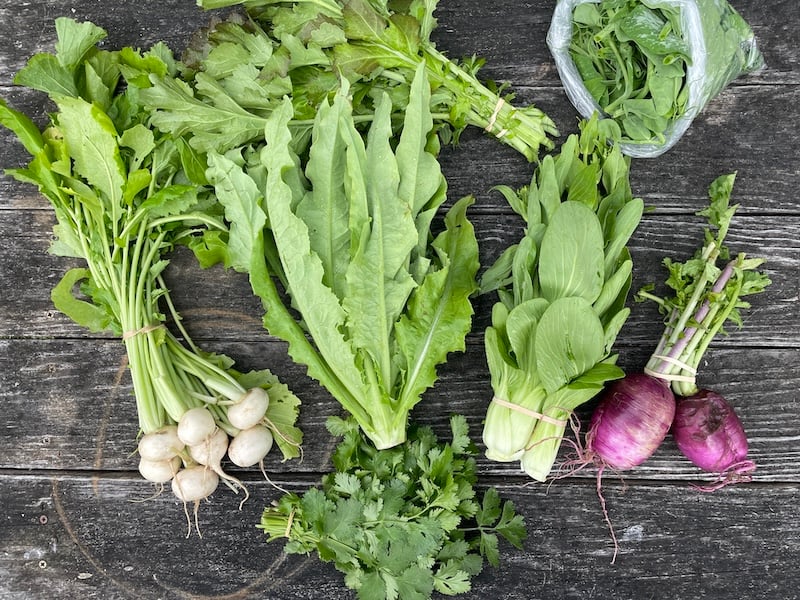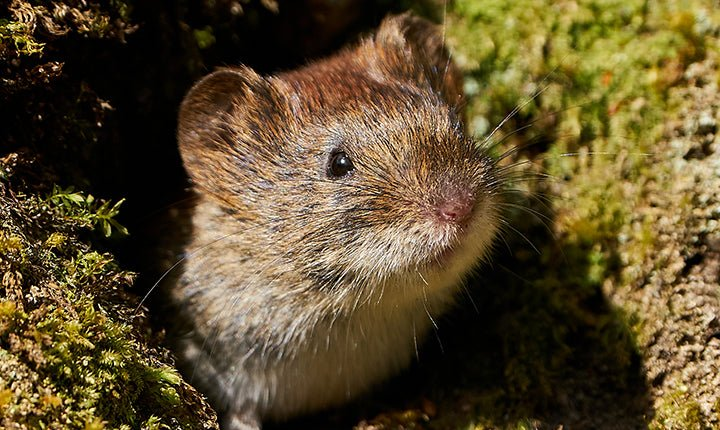CSA Week 1: Spring in a box

Tian Tian Farm Newsletter - CSA Week 1

This week’s share (L to R, top to bottom):
Oak fire mustards
Pea vines
Hakurei turnips
A choy
Baby bok choy raab
Purple daikon
Cilantro
Logistics:
Here’s to the beginning of Tian Tian Farm’s 2024 CSA season. Thank you so much for supporting our farm. Today (Wednesday) we are delivering to our Central District, Beacon Hill, and Vashon locations. Tomorrow will be West Seattle, Ballard, and Maple Leaf. You should have received an email with instructions for pick-up. If you have NOT received that email, please text me (Steven) ASAP: 314-728-3945.
Veggies:
That spiky-looking lettuce is a choy, one of our favorites. Per my mother, I like to chop it up into bite-sized pieces and toss it in a hot pan with oil, salt and garlic. You might have also tried Dough Zone’s raw preparation (a recipe for which you’ll find at the bottom).
We plant lots of baby bok choy for our farmers market and wholesale customers, but sometimes we don’t sell all of it in time and it begins to bolt. Thankfully, bolted baby bok choy is delicious. The stem (or raab) has a crisp, sweetness that goes perfectly in a stir-fry or, really, anything that you want to add a little bite to.
Hakurei turnips are the sweetest variety we know of. You’ll often see them at the farmers market because they are reliable (growers and sellers)! Halve them and throw them raw in a salad, or simmer them for a pleasant, teeth-sinking texture.
We salvaged about half of our first daikon crop from vole damage (more about that later). Some of you will receive roots with a little nibble or two, but we took care to select daikon whose wounds had healed. The rest of it went to us and our employees for fermenting and pickling.
Pea vines are another favorite, and something of a Tian Tian Farm specialty. I don’t know of another farm in Washington that plants peas specifically to harvest the tendrils. Most will take a cutting or two off their pea pod crops. We thickly sow three or four beds at a time and harvest them very early to bring you the most tender, fresh pea vines you’ll find in the state. We chop them roughly and toss them in a hot pan with salt (and a little water) for thirty seconds or so.
This is our first year growing mustards, and we bought our seed from our friends at Wild Dreams Farm. We honestly planted them for personal use to see if they would work for Chinese fermented mustard greens (maybe not, but hey!), but we realized that we planted waaaay too many (one fifty-foot, 30-inch bed) for a household of two.
We planted our first cilantro crop this season in a high-tunnel alongside tomatoes. We’ll try our best to always include an herb or allium in every box.
Voles

We spent the better part of a two May days planting eggplant in one of our hundred-foot high tunnels (they like the heat). It’s a process that involves clearing spring greens, sanitizing plastic mulch, setting up irrigation lines, and digging hundreds of holes. That’s not to mention the time it took to seed the eggplants back in March.
Imagine our disappointment, then, when our young eggplants became someone else’s lunch. One day, it was just a few. The next day, it was an entire row, chomped at the base before they even had a chance to flower.
A brief investigation brought us to the end of our tunnel. We saw the tattered remains of our deep purple seedlings, strewn about by creatures who cannot understand the pleasures of fish fragrant eggplant. We lifted a pile of greenhouse plastic and a whole family of voles scattered away.
Voles are probably the cutest pests we contend with at Tian Tian Farm. Elizabeth — who once had a pet rat — likes to pick them up and dote on their mousey features. They test our values as animal lovers. Ultimately, we decided that we love having a successful eggplant crop more.
The first step to controlling voles is removing their habitat. Voles need cover from predatory birds. The area around our eggplant hoop house happens to be one of our storage spots for our tarps, which we use for suppressing weeds for beds not in cultivation. Elizabeth and I rolled up our tarps and moved them a few meters away. We also cut some excess plastic off our hoop houses, which were dangling off the sides and bunched on the ground. It seemed like every time we moved a piece of plastic, we’d uncover another vole scampering to safety.
For extra protection, I laid out a couple dozen mouse traps around our eggplant, and sprinkled blood meal, a supposed deterrent, which will double as a source of nitrogen.
Thankfully, we seeded way more eggplant than we planned for, so we were able to replace the casualties. Now all we can do is hope for the best.
A Choy With Sesame Dressing
This is adapted (okay, basically copied) from Fuchsia Dunlop's The Food of Sichuan.

Ingredients
2 tsp sesame seeds
1 head A choy
1.5 tsp light soy sauce
3/4 tsp white sugar
2/3 tbsp cold water
2-3 tbsp sesame paste or tahini in a pinch (but I recommend the sesame paste)
1 tsp sesame oil
Salt
Steps
Toast sesame seeds in a pan on medium heat. Don't burn them. Set aside in a bowl.
Chop A choy into bite-sized pieces.
Combine soy sauce, sugar, sesame paste (with some oil from the jar). Stir vigorously. Stir in sesame oil. Add more water if necessary. Your dressing should have a little thickness to it, but should also pour easily. Salt to taste.
Arrange A choy nicely on a plate and drizzle dressing over it to your liking. Sprinkle sesame seeds on top. Alternatively, toss the salad with the dressing like a normal person (honestly, what we do when we're not trying to take a picture for our CSA newsletter).
‘Til next time,
Steven
